Plants, especially greenery, have never failed to bring good vibes to any space. Thus, you might begin to think about incorporating them into the rooms in your house. Then, you just realized that you do not have much floor space for planters or plant stands. Do not let this become a reason for you to give up. A floating planter could be the answer to your plant woes. This way, you can still have greenery in your house despite the limited space.
Once you get hold of one, this should prompt you to start using it. In fact, there are many different ways that could make your floating planter work better for you. Here are some ideas that would help you get started with it immediately
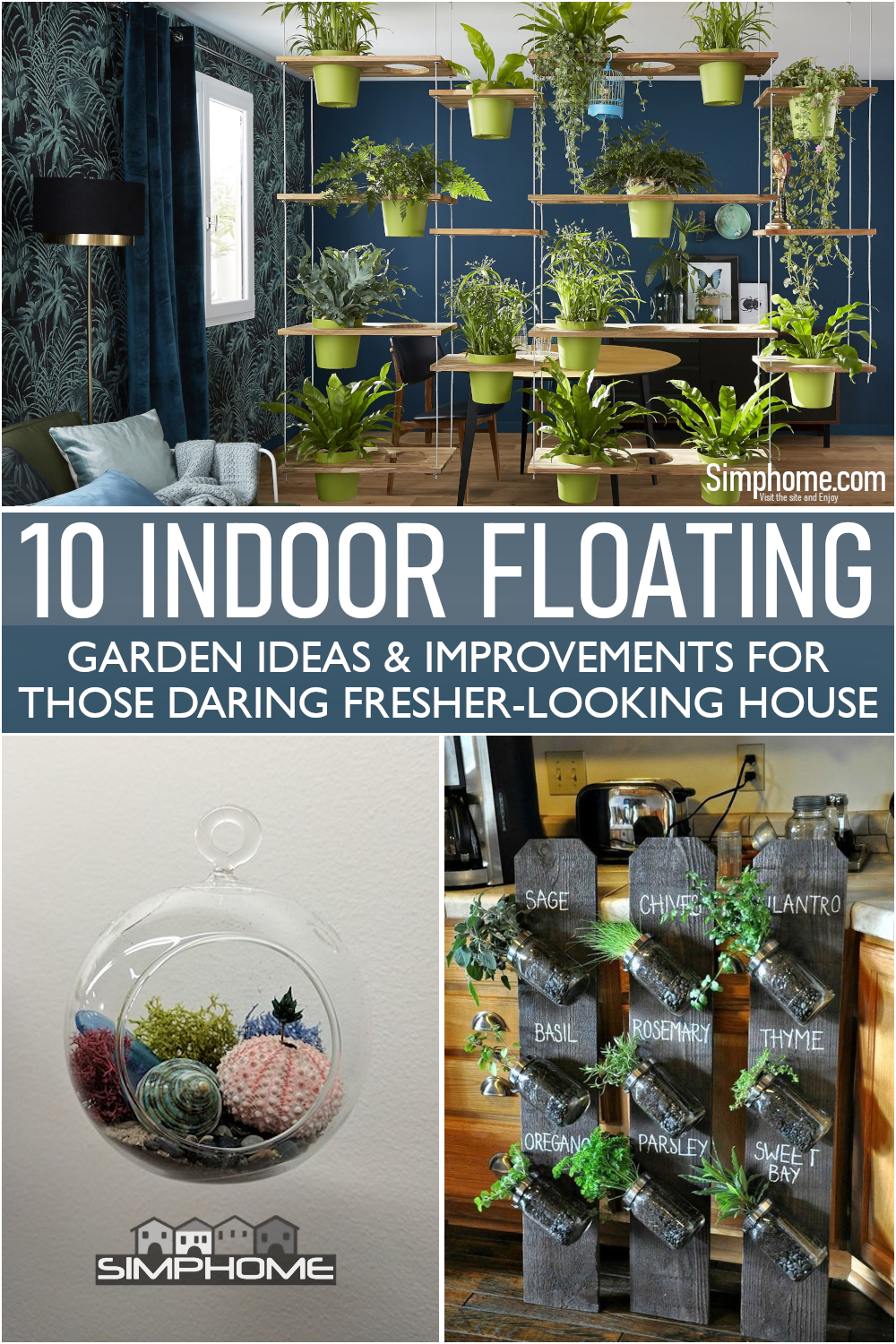
🔊10 Indoor Floating Garden Video:
Relevant Questions and Answers:
How do you build an indoor garden?
An indoor garden is a gardening project where the plants are grown indoors, usually in artificial sunlight. It may use recirculating water fed with controlled amounts of nutrients and may or may not have natural light from windows. In recent years, these gardens have become increasingly popular in households as well as commercial setups.
The first step to build an indoor garden is to pick your container or pot for planting.
Choosing a pot for planting is the first step in building an indoor garden. There are many different pots to choose from. You can choose pots that are plastic, terra cotta, or metal. You want to pick a pot that can handle high temperatures and has enough space for your plants to grow and flourish until they are ready to harvest. Make sure you also consider the type of dirt you will use and containers that you will need, such as water containers and fertilizer containers.
Also read: 10 Garden Ideas for A Small Yard
10+ DIY Potted Herb Garden Ideas
10 Indoor Succulent Garden Ideas
10 Interior Garden Ideas for Small House Owner
20 Clever and Cheap Indoor and Rooftop Garden Ideas
How do you build a vertical garden indoors?
Keeping it simple, the best materials to use for building a garden bench are cedar or redwood. Cedar is softer and will weather better than redwood, but redwood is more durable and longer-lasting. Whatever material you choose, make sure that it can withstand exposure to rain, wind, and sun (for example, by sealing it in with polyurethane or paint). The other thing you want about your garden benches is that they are reasonably comfortable to sit on–be sure that there’s enough clearance between the seat of the bench and the ground so that your thighs don’t hit dirt when you relax–and stable enough to support heavy pots without tipping over.
How do you make a mini indoor garden?
The first step is to construct a planter. You can make your own planter by using various types of containers such as clay pots, plastic pots, or even shoe boxes cut in half and cleaned out. Then you want to plant the seeds inside the pots or containers. The next step is watering and having light from the sun. You need to have artificial indoor lighting for your plants to grow and produce enough food for you or whoever may be using them.
Next, you want a water mat that will help feed your plants with nutrients so they can grow well without having any problems. A water mat dispenses water at set intervals while monitoring moisture levels, flow rates, and irrigation schedules on a display panel with an alarm.
The Persian Shield Plant, also known as the Chinese Evergreen, is a plant that is ideal for an indoor garden. The Persian Shield Plant is low-maintenance and has various sizes and shapes. There are very few leaves on this plant, making it perfect for an indoor garden because it will not need much sunlight or watering.
How do I start an indoor garden for beginners?
The easiest way to start an indoor garden is by buying. There are many different types of plants you can buy from home improvement stores that will grow indoors. Some plants will even come complete with a planter, making it easy for you to get started and take care of your plants right away.
As far as seeds are concerned, many different varieties are available at all garden supply stores that you can buy or find online at places like Amazon.
There are also varieties of vegetables that have been specifically bred for growing in pots and other containers (like so-called “indoor gardening vegetables”) like the broccoli raab, green pepper, celery, lettuce, leeks, onions, and tomatoes.
You will need a good container, soil, seeds, some potting mix, and water. Put in the seeds that you would like to grow and cover the top of your soil with plastic wrap (so that your seeds do not dry out). Water your soil and plant as per instructions from the seed packet or refer to a gardening book on indoor gardening. After about three weeks, you should see some plants growing.
Can you regrow beets from scraps?
The beets are the edible root of the beet plant. It has a sweet taste, and it belongs to the Amaranthaceae family. The taproot is what’s eaten, while the leaves can be eaten as well in mild cases, but it’s best not to eat them raw because of their toxic oxalic acid and nitrates. The beet contains a number of health-promoting substances, including betaine, folate, magnesium, potassium, copper, vitamin C, and calcium.
An individual trying to grow beets from scraps should start with an organic beet since this type will have less pesticide residue than other types that are grown with pesticides. The individual should cut off any outside parts that look bad or damaged before planting them.
How many beets does a plant produce?
A beet can produce a large number of beets. For example, in a square meter of land, one can grow up to twelve beets.
Can you grow beets from store-bought?
If you want to grow beets, you could buy them from store-bought. Once they have those roots, they can plant them and wait for three weeks to see that their beets are sprouting.
Will my beets still grow without tops?
The tops of the beets will die. The plant will still grow, but the tops will not have any leaves.
Do beets come back every year?
The beet plant is a biennial plant that will come back every year. They are also very hardy plants and can tolerate unfavorable conditions like extreme cold or hot and dry climates.
What happens if you don’t thin beets?
The plant will grow, but the beets will not have enough room to grow within the pot.
Do carrots need a lot of sun to grow?
Carrots, like many other plants, need sunlight to grow. They are also able to tolerate shade too. The carrot plant is a very versatile plant and can grow well in most climates without much extra care.
Can you regrow parsley from scraps?
The parsley is a herb that belongs to the Umbelliferae family of plants that can be grown from scraps or even seeds. It’s best not to eat raw parsley either because it contains oxalic acid and nitrates from the leaves, which should never be eaten raw. After all, they are toxic substances that may lead to stomach irritation and other maladies. If one wanted their own parsley crop, they could clipping some of the good-looking shoots growing.
Are sprouted beets safe to eat?
There is no risk of harm for being a sprouted beet because they are safe to eat.
Can I grow beets from beet tops?
A person can grow beets from beet tops, but it’s not recommended. People who would like to cherry-pick their own beets may want to save the tops and plant them in the following spring.
How long can beets stay in the ground?
Beets may last up to one year. They require good drainage and physical care, but they are easy to grow.
List Entries:
10 Cute & Easy Hanging Garden Ideas
10 Small Indoor Garden Ideas
10 Creative Ideas How to Improve Your Indoor with Flowers
35 Creative and Clever Indoor Garden Ideas
10. Fringed Macramé Plant Hangers
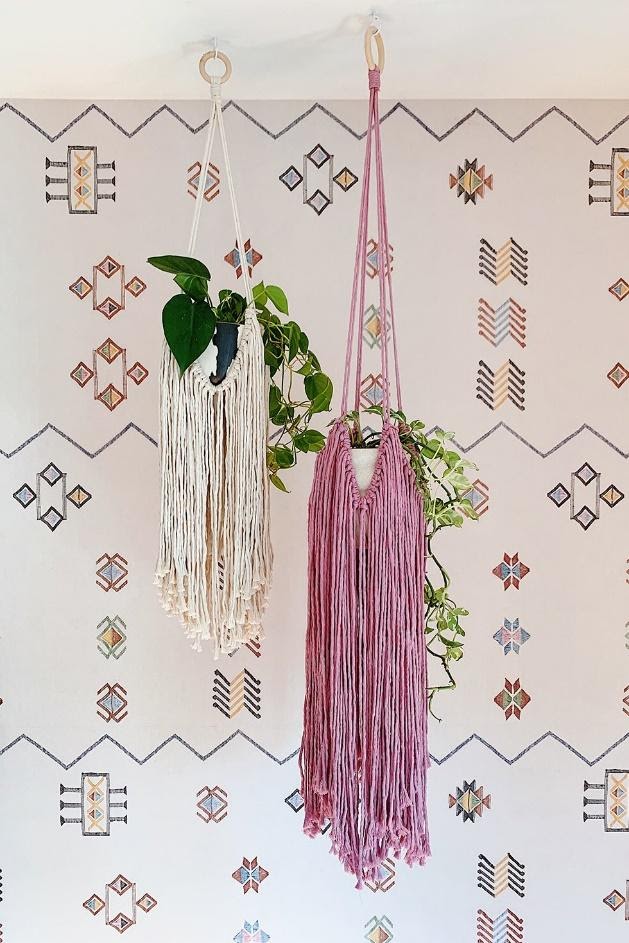 Are you into Bohemian chic? You should not miss this floating garden idea because it will awe anyone who sees it.
Are you into Bohemian chic? You should not miss this floating garden idea because it will awe anyone who sees it.
To make this hanger, you need to get 4 72” strands and cut them in half.
After that, fold them in half over a wooden ring.
Next, get an 8” strand and fold a quarter of it.
Lay it on top of the four strands.
After that, begin to wrap around the four strands right below the ring with it.
Now, it is time for you to tie two strands to form a square knot.
Continue doing this step until you get square knots at the same level.
After that, grab the right strand from one of the bundles, then tie it with the left strand you get from the adjacent bundle.
Keep doing this until you get four knots at the same height.
Then, begin to add the fringes.
Once you are finished adding fringes, wrap the bottom of your macramé.
This way, the pot that you are going to use will stay in place.
Finally, screw an eyehook to the ceiling to hold the ring of the fringed macramé. Simply hang a planter with greenery, especially climbers such as Devil’s Ivy, Philodendron, or String of Pearls. The dangling leaves and fringes will create a dramatic look instantly.
9. Kokedama String Garden Idea
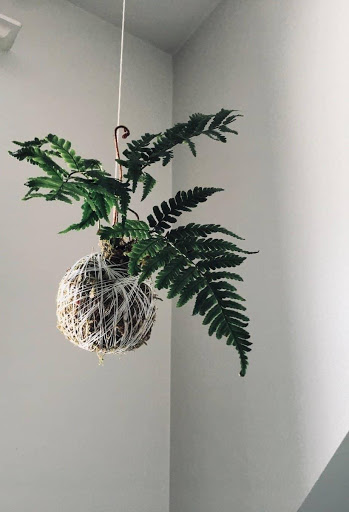 Have you ever heard anything about Japanese moss ball, Kokedama? It is a gardening technique that entails wrapping roots with soil, moss, and string. People used to display it on slabs, driftwood, or platforms. But now, they hang it from the ceiling to create a floating garden.
Have you ever heard anything about Japanese moss ball, Kokedama? It is a gardening technique that entails wrapping roots with soil, moss, and string. People used to display it on slabs, driftwood, or platforms. But now, they hang it from the ceiling to create a floating garden.
To make a Kokedama, you need to take a plant from the pot and remove any loose soil from its roots. After that, arrange the roots gently into a loose ball.
Next, you can begin to pack a soil mixture around the roots to form the ball. Set it aside.
Prepare the moss blanket by arranging your moss into a blanket. It is supposed to be an inch thick, and make sure it does not have any holes or bare patches. Next, wrap the soil ball with the moss sheet. After that, wrap it with string. Finally, you can hang your Kokedama.
Since Kokedama is made of moss, which thrives in partial shade and moist soil, you need to find plants that require the same conditions. Boston fern, ivy, orchid, and anthurium would be your safe bet.
For an easier option, opt for succulents. They never go wrong. Besides, some of them can put up with moist soil. They can also thrive in relatively low light conditions. Nonetheless, your floating planter will still look great with other kinds of greenery. You could also include herbs and wildflowers for a more dynamic touch.
If you would like to put up some living walls, you would need to use special plants to get the job done. Ideally, the roots of your plants should be able to grip on the sides of the planter once they start growing. Moreover, consider starting with small plants so that they can grow all throughout the season.
You have to make sure that your floating planter is stable enough when it comes to its size and weight. In particular, it should be heavy enough to anchor itself down in the water.
Also read:
10 Cute & Easy Hanging Garden Ideas
10 Small Backyard Vegetable Garden Ideas
40+ DIY Flower Garden, Planter, and Container Ideas
8. Hanging The Terrarium
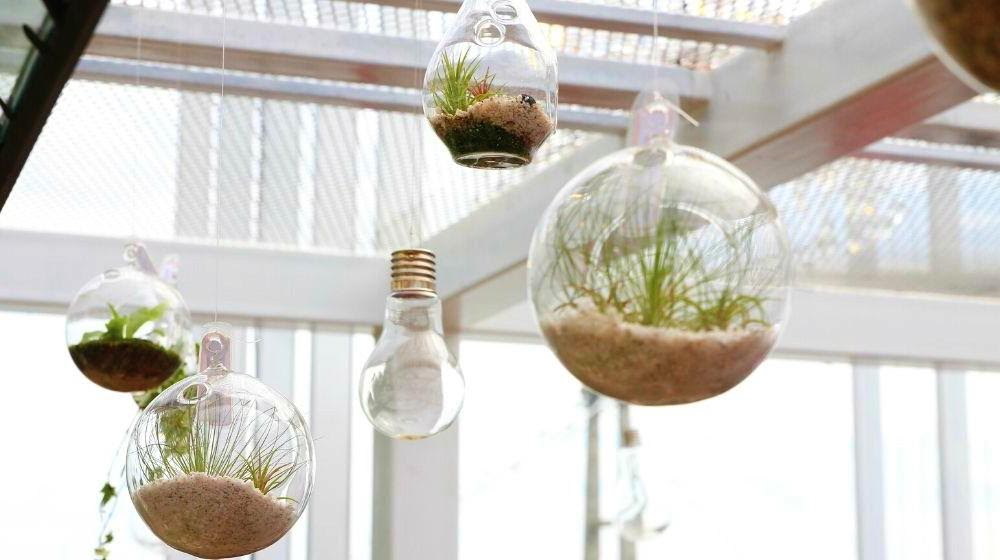 Hanging terrariums will add a whimsical charm to your home. More importantly, you can make one yourself to meet your need.
Hanging terrariums will add a whimsical charm to your home. More importantly, you can make one yourself to meet your need.
To make a terrarium, you need a glass globe. But if you cannot find it, you can use a glass jar or bowl. You will also require some sand, activated charcoal, succulent soil, mosses, bark, shells, and pebbles.
All you need to do is just using your imagination to craft a terrarium that you like. Try combining sand, pebbles, moss, and small plants to carve out a dramatic look.
You had better opt for slow-growing plants. Therefore, succulents would be your greatest bet. You can also use ferns, air plants, peperomia, ferns, dwarf palms, or carnivorous plants.
7. A Mason Jar Herb Garden Idea
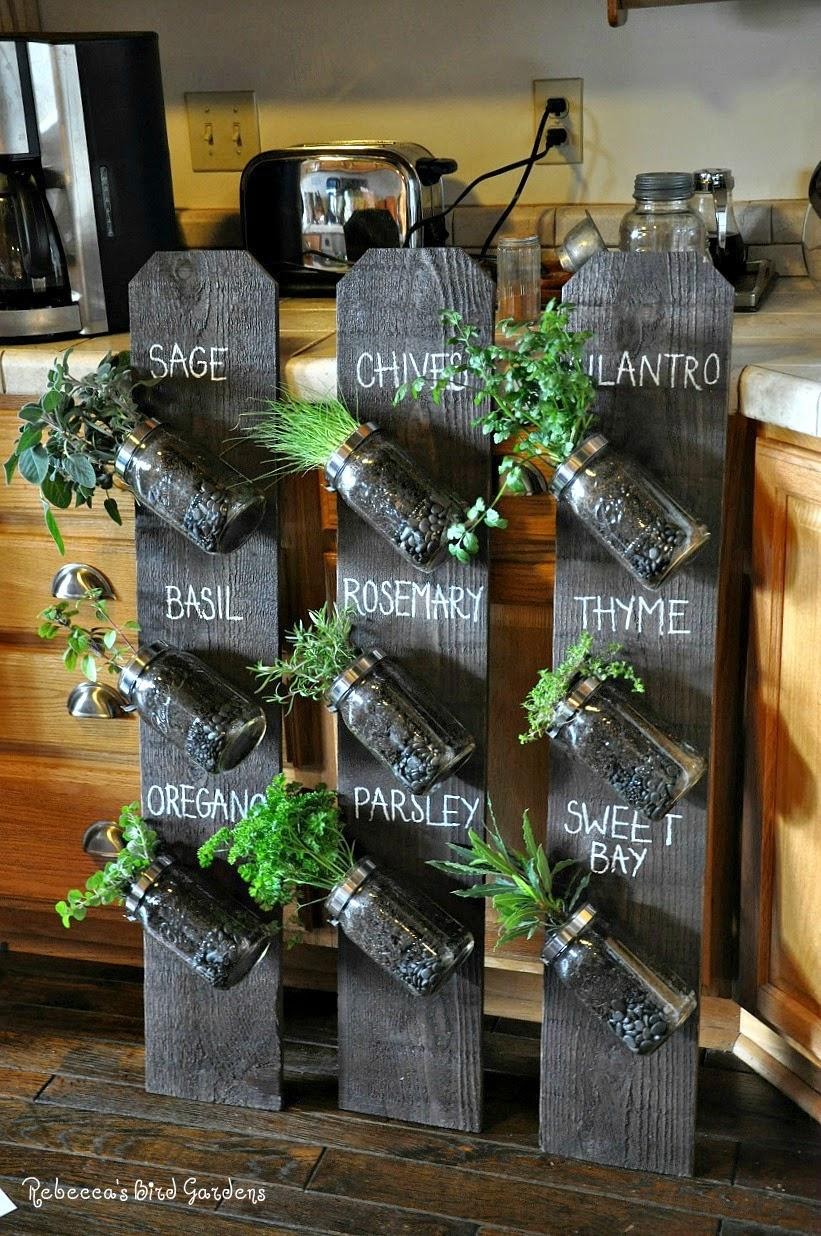 Mason jars are incredibly versatile. You can even turn them into a spectacular herb garden.
Mason jars are incredibly versatile. You can even turn them into a spectacular herb garden.
To make this floating herb garden, you need to cut your board to the desired length. Screw hose clamps that you will use to hold the jars in place to it. Make sure you leave 10 inches in between.
Next, fill each jar with gravel and then soil. Place the herbs in them and position them in each hose clamp. Then, tighten the clamps so that the planters will stay in place.
6. The Plant Room Divider Idea
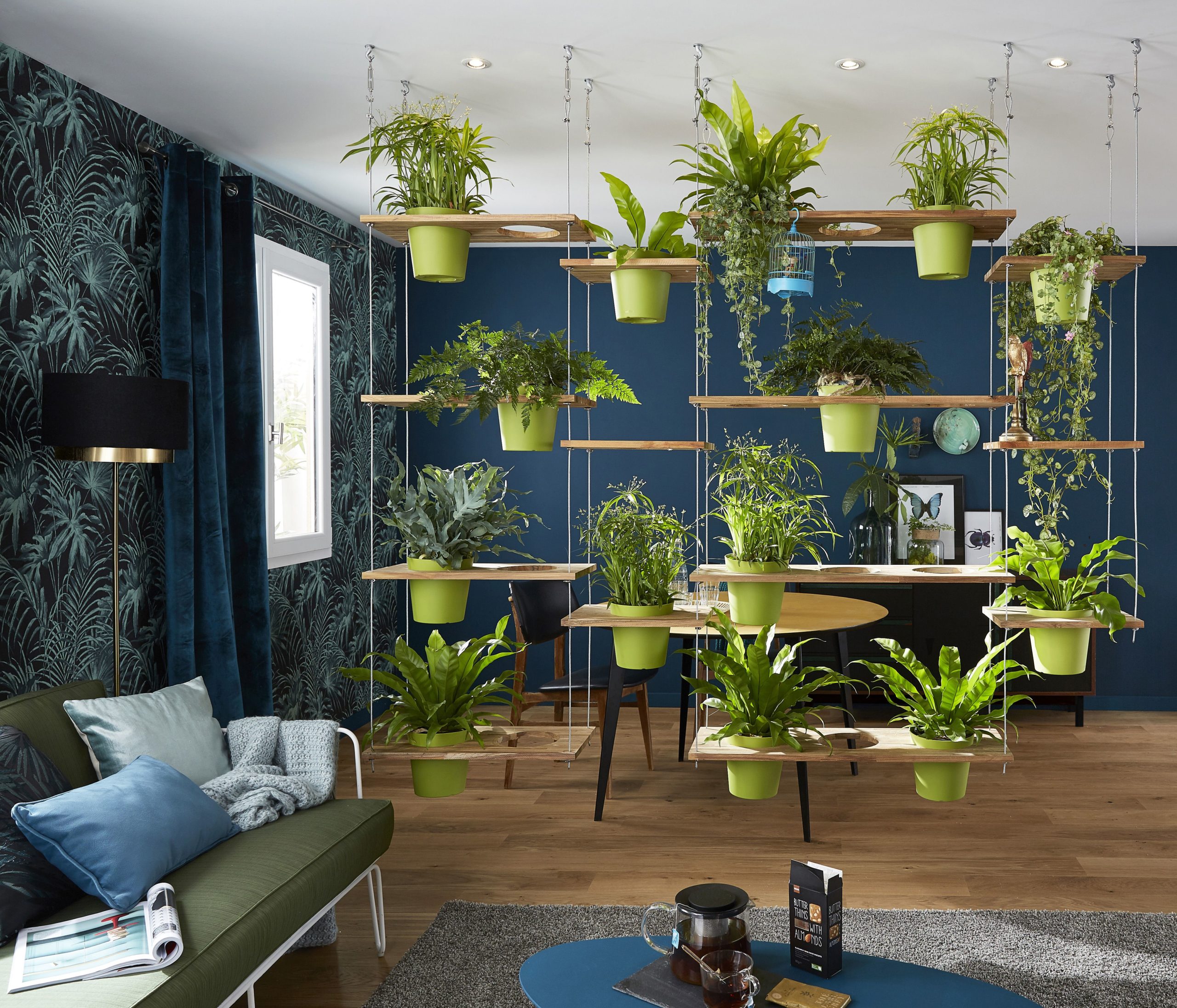
This room divider serves double duty. Besides separating the dining room and the living room, it can also host various greenery that you like. More importantly, the plants can refresh the air in your home without taking up the floor space.
5. The Floating Plants with Pegboard Idea
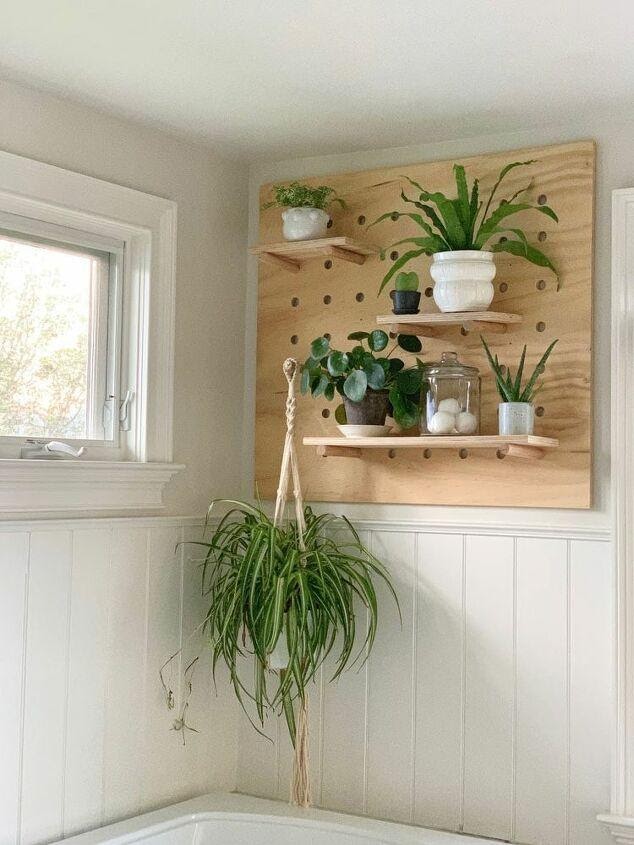 Many people use pegboards to store their tools in the garage or kitchen utensils. You can also use them to host and display your plants. What makes them extraordinary is you can make one yourself without breaking a sweat.
Many people use pegboards to store their tools in the garage or kitchen utensils. You can also use them to host and display your plants. What makes them extraordinary is you can make one yourself without breaking a sweat.
You just need to get plywood and some wooden dowels. After that, drill holes into the board. Finally, install the dowels in each hole.
Try topping some dowels with some pieces of board to create shelving if necessary. Once the shelves are ready, place your plants and beautiful planters on them.
4. Hang Them over a Curtain Rod
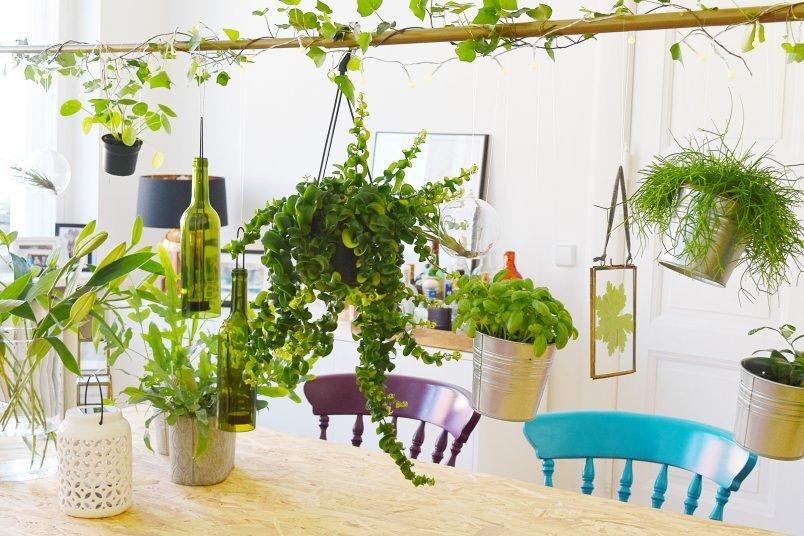 Hanging plants from a curtain rod is not a new thing. But it never gets old since it is the easiest way to grow plants indoors, especially if you are short on space.
Hanging plants from a curtain rod is not a new thing. But it never gets old since it is the easiest way to grow plants indoors, especially if you are short on space.
This curtain rod, for example, lies over a dining table and hosts succulents and herbs. To make it look more appealing, you can also hang battery-operated lights or flameless candles.
You can also try wrapping ivy and string lights around the rod to accentuate the romantic vibes.
3. The Wall-Mounted Staghorn Fern
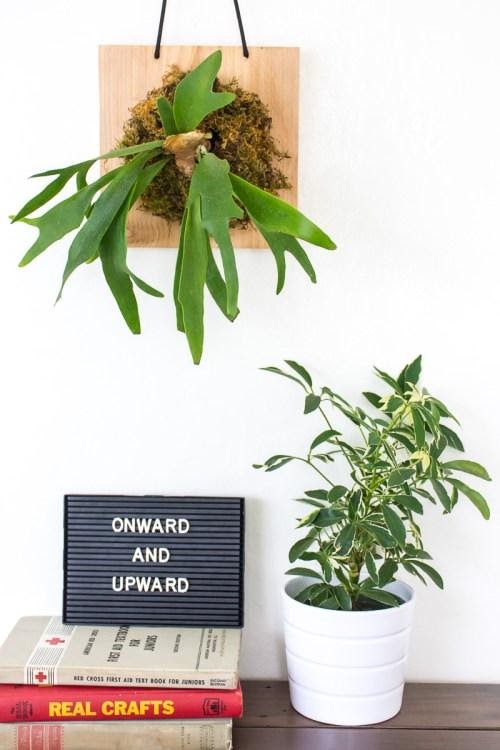 Bring the charm of a tropical look to your living room by creating a wall-mounted staghorn fern. It may not be easy, but it does not mean you cannot replicate it.
Bring the charm of a tropical look to your living room by creating a wall-mounted staghorn fern. It may not be easy, but it does not mean you cannot replicate it.
First, get a wooden board and cut it into a square. After that, remove the fern from the pot. Once the pot is empty, place it facedown right in the center of the board. Then, trace it with a pencil. Next, install stainless steel screws along the trace.
Grab the fern and wrap it with netting or tulle fabric. Then, place it on the square board with the screws surround it.
Next, wrap sheet moss around the netting. Make sure you do not cover the fronds. If you can still see the screws, tuck more moss to conceal them. Finally, hang your fern.
2. The Hanging Coconut Planters
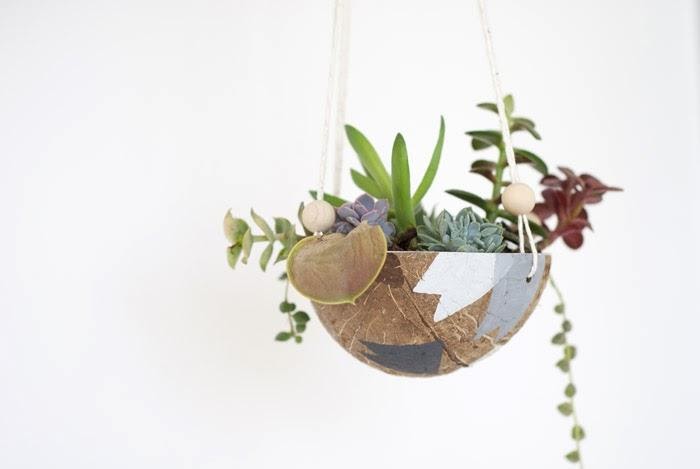 Incorporate an exotic touch into your home by growing succulents in half of the coconut shells.
Incorporate an exotic touch into your home by growing succulents in half of the coconut shells.
First, you need to paint your half coconut shell. Once it is dry, drill a hole at the bottom for the drainage and four holes at the top. After that, you can begin to put the soil and arrange the succulents in it.
Also read: 10 Beautiful Leather Plant Holders Worth Trying
Lastly, Number 1. Wrap Around the Canopy
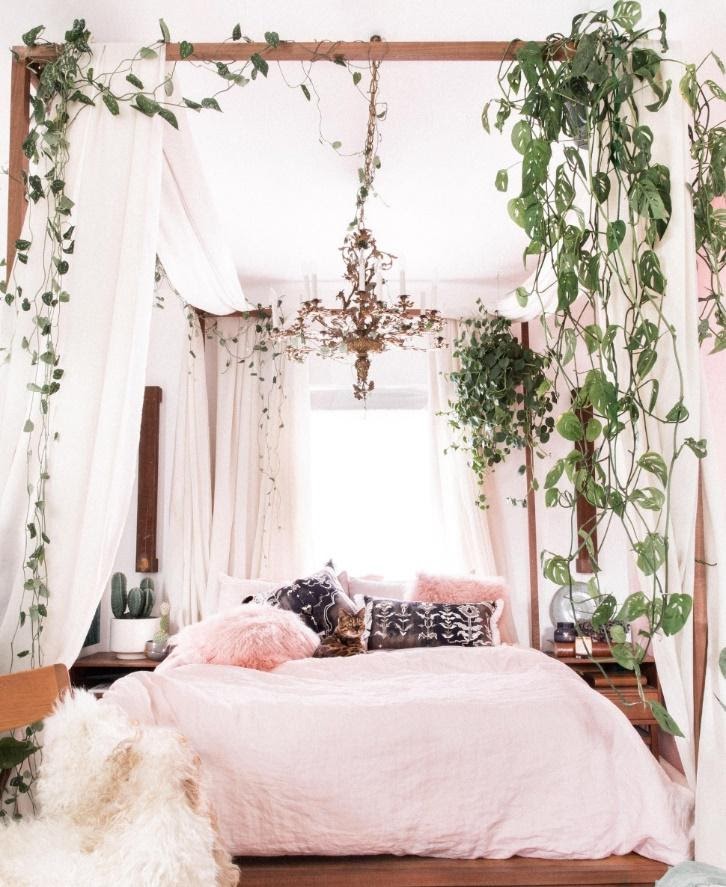 Growing indoor plants in the bedroom? Why not? It can add a little bit of a dramatic and romantic look to your bedroom.
Growing indoor plants in the bedroom? Why not? It can add a little bit of a dramatic and romantic look to your bedroom.
There are various ways you can try to make this idea tangible. You can invest in some fancy planters, such as building a shelf to host them or installing a canopy over your bed.
To carve out romantic vibes, you can just install a canopy and wrap climbing plants around it. The best plants that can perform this task well are Philodendron and Photos because they thrive in indirect natural light. They are also drought tolerant.
Who says that growing plants indoors is a pie in the sky? These 10 indoor floating garden ideas have proven that you can add some greenery despite the limited space.
Bonus idea: Build a Floating Garden in a Water Bowl
This is the perfect idea for those who would like to create their own mini pond in the house. Instead of buying one, you can even make one by assembling an attractive water bowl. As shown in the picture above, you would need to add some plants as well as stones and marbles for the desired effect. This idea can also be used to improve your indoor garden’s aesthetic appeal.
If your floating planter is made of PVC pipe, it should be completely waterproof to avoid any leaks. Alternatively, you could consider silicone caulk around its edges so that it does not leak when placed on a wet floor or piece of furniture.
References:
10. Honestlywtf.com
9. Homefortheharvest.com
8. Instructables.com, Diyprojects.com, Ambius.com
7. Rebeccasbirdgardensblog.blogspot.com
6. Squareinchhome.com
5. Hometalk.com
4. Littlehouseonthecorner.com
3. Diyinpdx.com
2. Poppytalk.com
1. Architecturaldigest.com